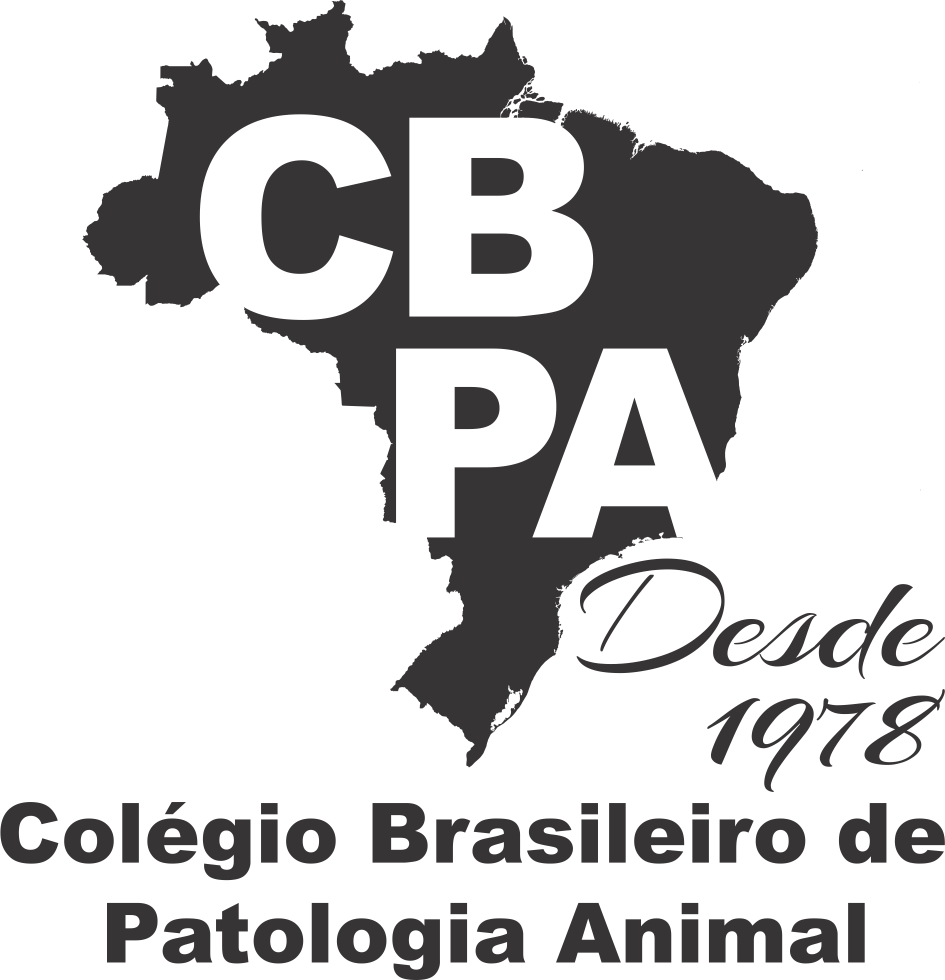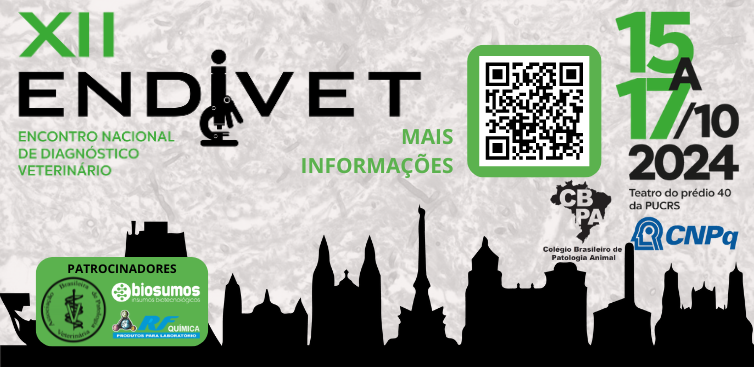Resultado da pesquisa (484)
Termo utilizado na pesquisa pathology
#1 - Clinical, pathological and immunohistochemical characterization of spontaneous neoplasms in pet rodents in Northeastern Brazil
Abstract in English:
In the last decade, there has been a significant increase in the demand for small rodents such as hamsters, guinea pigs, rats, and mice to be kept as pets. Consequently, the veterinary care provided to these animals has also increased. The aim of this study was to describe gross, histopathological and immunohistochemical findings of 26 spontaneous neoplasms diagnosed in 25 pet rodents in Northeastern Brazil. A retrospective study was carried out from 2014 to 2022 in two veterinary diagnostic laboratories to identify cases of tumoriform lesions in these species. Hamsters represented the most frequent species in this study (60%, 15/25), followed by rats (28%, 7/25), guinea pigs (8%, 2/25), and mice (4%, 1/25), with a mean age of 17.63 months. The anatomical regions of the face/head and thoracic region were the most affected. The most affected tissues were the skin/subcutaneous/mucosal (65%, 15/26) and mammary gland (23%, 6/26). Eighteen different types of neoplasms were diagnosed, and T-cell lymphomas and mammary adenocarcinomas were the most diagnosed tumors, each corresponding to 12% (3/26) of the cases. Leiomyosarcoma, myxosarcoma and mammary adenocarcinoma metastases were also noted. Immunohistochemistry was essential for the diagnosis of certain malignant mesenchymal and round-cell neoplasms. Pet rodent neoplasms in Northeastern Brazil are common, especially in hamsters, and immunohistochemistry can be a useful tool for the definitive diagnosis of these tumors.
Abstract in Portuguese:
In the last decade, there has been a significant increase in the demand for small rodents such as hamsters, guinea pigs, rats, and mice to be kept as pets. Consequently, the veterinary care provided to these animals has also increased. The aim of this study was to describe gross, histopathological and immunohistochemical findings of 26 spontaneous neoplasms diagnosed in 25 pet rodents in Northeastern Brazil. A retrospective study was carried out from 2014 to 2022 in two veterinary diagnostic laboratories to identify cases of tumoriform lesions in these species. Hamsters represented the most frequent species in this study (60%, 15/25), followed by rats (28%, 7/25), guinea pigs (8%, 2/25), and mice (4%, 1/25), with a mean age of 17.63 months. The anatomical regions of the face/head and thoracic region were the most affected. The most affected tissues were the skin/subcutaneous/mucosal (65%, 15/26) and mammary gland (23%, 6/26). Eighteen different types of neoplasms were diagnosed, and T-cell lymphomas and mammary adenocarcinomas were the most diagnosed tumors, each corresponding to 12% (3/26) of the cases. Leiomyosarcoma, myxosarcoma and mammary adenocarcinoma metastases were also noted. Immunohistochemistry was essential for the diagnosis of certain malignant mesenchymal and round-cell neoplasms. Pet rodent neoplasms in Northeastern Brazil are common, especially in hamsters, and immunohistochemistry can be a useful tool for the definitive diagnosis of these tumors.
#2 - Serum and immunohistochemical analyses of troponin I in sheep experimentally poisoned with Palicourea marcgravii
Abstract in English:
Palicourea marcgravii is a lethal toxic plant widely distributed in Brazil. Ingestion of this plant causes cardiotoxic effects in animals, leading to acute heart failure without evident macroscopic changes in the heart due to the rapid progression of the disease. Currently, the diagnosis is confirmed based on microscopic identification of characteristic renal lesions. Although troponin is used as a biomarker for myocardial lesions in human and veterinary medicine, its serum levels in sheep poisoned with P. marcgravii remain unknown. The objective of this study was to determine serum levels of troponin I and evaluate its expression in incipient heart lesions in sheep. Eight male sheep were experimentally intoxicated with 1g kg-1 of fresh P. marcgravii plants. The animals were physically examined every two hours, and blood samples were collected before the administration of the plant material and during the agonizing period immediately before death. Additionally, necropsy and immunohistochemistry were performed on cardiac tissue samples. All animals presented minimal serum levels of troponin I before plant administration, with a significant increase in these levels immediately before death, indicating leakage due to the cardiac injury. These results confirm the hypothesis that troponin is released into the bloodstream before morphological changes in the myocardium can be observed through conventional microscopy and immunohistochemical testing. These findings contribute to understanding the pathological mechanisms of this toxicity and may assist in the early diagnosis and treatment of affected animals.
Abstract in Portuguese:
Palicourea marcgravii é uma planta tóxica letal e amplamente disseminada no Brasil. Sua ingestão causa efeitos cardiotóxicos em animais, levando à insuficiência cardíaca aguda sem alterações macroscópicas evidentes no coração devido à rápida progressão da doença. A confirmação do diagnóstico atual se baseia na identificação microscópica das lesões renais características. Embora a troponina seja usada como biomarcador de lesões miocárdicas na medicina humana e veterinária, seus níveis séricos em ovinos intoxicados por P. marcgravii ainda são desconhecidos. O objetivo deste estudo foi determinar os níveis séricos de troponina I e avaliar sua expressão em lesões incipientes no coração de ovinos. Oito ovinos machos foram experimentalmente intoxicados com 1g/kg da planta fresca. Os animais foram avaliados fisicamente a cada duas horas, e tiveram seu sangue coletado antes da administração da planta e durante a fase agônica, antes do óbito. Além disso, foram realizadas necropsia e imunohistoquímica em fragmentos cardíacos. Todos os animais apresentaram níveis mínimos de troponina antes da administração da planta, e mostraram aumento expressivo imediatamente antes do óbito, indicando extravasamento devido à lesão cardíaca. Esses resultados confirmam a hipótese de que a troponina é liberada na corrente sanguínea antes das alterações morfológicas no miocárdio serem observadas pela microscopia convencional e imunohistoquímica. Esses achados contribuem para a compreensão dos mecanismos patológicos dessa intoxicação e podem auxiliar no diagnóstico precoce e tratamento em animais afetados.
#3 - Feline application/inflammation-associated sarcoma: Gross aspects and histomorphological
Abstract in English:
Feline injection-site sarcomas in felines account for more than 40% of cutaneous and subcutaneous neoplasms in felines. The present study aimed to describe the macroscopic and histomorphological findings of feline application/injection sarcomas. Samples from 31 feline tumors with a history of feline application/inflammation sarcoma were re-evaluated regarding histological subtype, mitotic index and score, depth of tissue invasion, and presence of inflammation considering the location, intensity and predominant cell types. Of the 31 samples from felines diagnosed with sarcoma at the application/inflammation site, 87.15% were cats with no defined breed (NDB), with a mean age of 8.5 years. The predominant anatomical sites were the back and flank/abdomen, both with 29% (9/31), and the prevalent histological subtype was fibrosarcoma at 77.4% (24/31), followed by anaplastic giant cell sarcoma at 12.9% (4/31) and myxosarcoma 9.6% (3/31). The histological grade with the highest number of cases was III (51.6%), followed by Grade II (35.4%) and I (12.9%). The mean of the longest axis measurements varied between the different tumor grades without being significant, with the average being 2.5±2.79cm in Grade I tumors and 3.2±2.28cm in Grade II tumors. and 4.68±2.07cm in Grade III tumors. Necrosis was observed in 74.2% of tumors. The tissue inflammation score was mild to moderate in 58% of cases and severe in 32.2%, with lymphocytic and lymphoplasmacytic infiltrates being prevalent, with 25.8% each, followed by lymphoplasmohistiocytic with 22.6%. The infiltration depth was 38.7% in muscle tissue, followed by 32.2% in the subcutaneous tissue. Pleomorphism was accentuated in 51.6%. Desmoplasia was moderate in 45.1%. Satellite nodules were present in 29% of cases, and 19.4% had macrophages with intracytoplasmic content suggestive of adjuvants. Surgical margins were infiltrated (M1) in 48.4% and narrowed in 25.8% (M2). The anatomical locations observed were different from those recommended by the Vaccine-Associated Feline Sarcoma Task Force (VAFST); in most cases, the adjuvanted macrophage was not present. From this data, we can suggest that sarcomas in felines are not only correlated to the vaccine application, corroborating the hypothesis that any material, whether liquid or solid, and any chronic inflammatory process in the subcutaneous tissue of cats can induce the entity if they are predisposed to do so. The detailed histomorphological data evaluated in this study were key points and provided important information about tumor behavior, being a tool for clinical-oncological decision-making.
Abstract in Portuguese:
Feline injection-site sarcomas in felines account for more than 40% of cutaneous and subcutaneous neoplasms in felines. The present study aimed to describe the macroscopic and histomorphological findings of feline application/injection sarcomas. Samples from 31 feline tumors with a history of feline application/inflammation sarcoma were re-evaluated regarding histological subtype, mitotic index and score, depth of tissue invasion, and presence of inflammation considering the location, intensity and predominant cell types. Of the 31 samples from felines diagnosed with sarcoma at the application/inflammation site, 87.15% were cats with no defined breed (NDB), with a mean age of 8.5 years. The predominant anatomical sites were the back and flank/abdomen, both with 29% (9/31), and the prevalent histological subtype was fibrosarcoma at 77.4% (24/31), followed by anaplastic giant cell sarcoma at 12.9% (4/31) and myxosarcoma 9.6% (3/31). The histological grade with the highest number of cases was III (51.6%), followed by Grade II (35.4%) and I (12.9%). The mean of the longest axis measurements varied between the different tumor grades without being significant, with the average being 2.5±2.79cm in Grade I tumors and 3.2±2.28cm in Grade II tumors. and 4.68±2.07cm in Grade III tumors. Necrosis was observed in 74.2% of tumors. The tissue inflammation score was mild to moderate in 58% of cases and severe in 32.2%, with lymphocytic and lymphoplasmacytic infiltrates being prevalent, with 25.8% each, followed by lymphoplasmohistiocytic with 22.6%. The infiltration depth was 38.7% in muscle tissue, followed by 32.2% in the subcutaneous tissue. Pleomorphism was accentuated in 51.6%. Desmoplasia was moderate in 45.1%. Satellite nodules were present in 29% of cases, and 19.4% had macrophages with intracytoplasmic content suggestive of adjuvants. Surgical margins were infiltrated (M1) in 48.4% and narrowed in 25.8% (M2). The anatomical locations observed were different from those recommended by the Vaccine-Associated Feline Sarcoma Task Force (VAFST); in most cases, the adjuvanted macrophage was not present. From this data, we can suggest that sarcomas in felines are not only correlated to the vaccine application, corroborating the hypothesis that any material, whether liquid or solid, and any chronic inflammatory process in the subcutaneous tissue of cats can induce the entity if they are predisposed to do so. The detailed histomorphological data evaluated in this study were key points and provided important information about tumor behavior, being a tool for clinical-oncological decision-making.
#4 - Clinical, histopathological, and hematological changes due to isoimmune thrombocytopenic purpura in piglets
Abstract in English:
Isoimmune thrombocytopenic purpura (ITP) is an immune-mediated disease that causes severe hemorrhagic lesions and high mortality in piglets. The disease can occur early in newborn piglets (EITP) or late in 2- to 3-week old piglets (LITP). In this study, we analysed the clinical, pathological, and hematological aspects of 391 ITP cases (312 with EITP and 79 with LITP). In LIPT cases, morbidity and mortality rates were higher, with rates of 60% (morbidity) and 53% (mortality). The main clinicopathological findings in ITP cases were different patterns of hemorrhages organs and tissues. In EITP, clinical signs were characterized by extensive subcutaneous hemorrhages and death occurred within a few days; however, in LITP, often sudden death occurred. In macroscopic analysis, hemorrhagic diathesis was observed in all affected animals. In EITP, the most severe hemorrhagic lesions were integumentary, mainly in the dermis and epidermis. In LITP, visceral lesions were predominant, mainly in the epicardium and intestines. Microscopic bone marrow analysis revealed mild cellular hyperplasia in EITP and bone marrow aplasia in LITP. hematological analyses revealed leucopenia, thrombocytopenia, and anemia in all ITP-affected animals. However, fostering by a different sow was only efficient in controlling EITP and had little effect in LITP-symptomatic piglets, due to more severe lesions. Further studies on the etiopathogenesis of LITP are required to improve our understanding of this disease form.
Abstract in Portuguese:
Púrpura trombocitopênica isoimune (PTI) é uma doença imunomediada que causa lesões hemorrágicas graves e alta mortalidade em leitões, que pode se apresentar através de uma forma precoce em leitões neonatos (PTIP) ou uma forma tardia em leitões com duas a três semanas de idade (PTIT). Neste trabalho analisamos aspectos clínicos, hematológicos e histopatológicos de 391 casos de PTI, sendo 312 de PTIP e 79 de PTIT. Observou-se maiores morbidade (60%) e mortalidade (53%) na PTIT. Os principais achados clínico-patológicos observado na PTI são hemorragias em diferentes graus de intensidade e nos diferentes órgãos e tecidos. Na PTIP observou-se predominantemente hemorragias subcutâneas extensas e morte em alguns dias, já na PTIT, observou-se além de grave hemorragia, morte súbita. Na análise macroscópica, observou-se diátese hemorrágica em todos os animais afetados. Na PTIP as lesões hemorrágicas mais graves foram tegumentares, principalmente em derme e epiderme, enquanto, na forma tardia, observou-se lesões predominantemente viscerais, em epicárdico e intestino. A análise microscópica de medula óssea revelou discreta hiperplasia celular na forma PTIP, enquanto, na PTIT observou-se aplasia medular. Na análise hematológica observou-se leucopenia, trombocitopenia e anemia em todos os animais com PTI. Os achados clínicos, histopatológicos e hematológicos para PTIP e PTIT da doença permitiram o diagnóstico de PTI. Entretanto, a troca de mãe se mostrou eficiente apenas para controle PTIP, uma vez que, esta estratégia apresenta pouco resultado para leitões sintomáticos com a PTIT, devido lesões mais severas. Estudos sobre a etiopatogênese da PTIT ainda são necessários para melhor entendimento desta forma da doença.
#5 - Lesions of the oral cavity of dogs: 720 cases
Abstract in English:
Seven hundred twenty cases of oral cavity lesions in dogs were diagnosed from 2015 to 2020 in Distrito Federal, Brazil. Four hundred thirty-two (60%) lesions were neoplastic, and 288 (40%) were non-neoplastic. Of the neoplasms, 229 (53%) were considered malignant and 203 (47%) benign, affecting mainly males, of 43 different breeds, with an average age of 9.4 years, mainly the gum and lip. Melanoma was the most (96/432, 22.2%) commonly diagnosed neoplasm, followed by peripheral odontogenic fibroma (68/432, 15.7%), papilloma (63/432, 14.5%) and squamous cell carcinoma (SCC) (56/432, 12.9%). Non-neoplastic lesions also affected males predominantly, from 41 different breeds, with an average age of 8.9 years, mainly in the gums, lip, and tongue. These lesions were diagnosed as inflammatory (230/288, 79.8%), hyperplastic (47/288, 16.3%) and other lesions (11/288, 3.8%).
Abstract in Portuguese:
Foram estudados 720 casos de lesões na cavidade oral em cães diagnosticados entre 2015 e 2020, no Distrito Federal. Dessas alterações, 432 (60%) foram neoplásicas e 288 (40%) não neoplásicas. Dentre os neoplasmas, 229 (53%) foram consideradas malignos e 203 (47%) benignos, acometendo principalmente machos, de 43 raças diferentes, com idade média 9,4 anos, afetando principalmente gengiva e lábio. Melanoma foi o neoplasma mais comumente diagnosticado (96/432; 22,2%), seguido do fibroma odontogênico periférico (68/432; 15,7%), papiloma (63/432; 14,5%) e carcinoma de células escamosas (56/432; 12,9%). As lesões não neoplásicas também acometeram predominantemente machos, de 41 raças diferentes, com idade média 8,9 anos, afetando principalmente gengiva, lábio e língua. Essas lesões foram diagnosticadas como inflamatórias (230/288; 79,8%), hiperplásicas (47/288; 16,3%) e como outras alterações (11/288; 3,8%).
#6 - Searching bovine papillomavirus presence in lesions seen on teats of cows
Abstract in English:
The samples were taken from 106 cows with various-looking lesions on their teats and ranged in age from 2 to 8 years. Enzyme-linked immunosorbent assay (ELISA) antigen (Ag) positive for the bovine papillomavirus (BPV) was found in 59 (55.7%) blood serum samples. PCR using FAP59/64 primers was positive for 24 (22.6%) samples. BPV-2 (40, 37.7%), BPV-6 (28, 26.4%), BPV-8 (30, 28.3%), BPV-9 (36, 34%), BPV-10 (32, 30.3%), and BPV-12 (22, 20.8%) were found in a PCR type-specific analysis of single and mixed type teat warts. The highest positivity was observed in BPV-2, BPV-9 and BPV-10 in flat and round forms, BPV-6, BPV-10, BPV-12, and mixed types in rice grain-cauliflower forms, BPV-9 and mixed types in filiform in the distribution of types based on the macroscopic appearance of teat lesions. As for the distribution of BPV types according to age, the most BPV-2 types were found in the age group of two years, the most BPV-10 types in the age group of three years, the most BPV-9 types in the age group of four years, the most BPV-8+BPV-12 types in the age group of five years, and the most mixed types between the ages of six and eight years. The existence of the virus was then checked using electron microscopy on the chosen samples (at least one investigation was conducted), and it was positively identified using BPV type-specific primers. The authors concluded that BPV detection using an ELISA (Ag) test from blood serum samples was shown to be less sensitive than BPV type-specific PCR from wart samples.
Abstract in Portuguese:
The samples were taken from 106 cows with various-looking lesions on their teats and ranged in age from 2 to 8 years. Enzyme-linked immunosorbent assay (ELISA) antigen (Ag) positive for the bovine papillomavirus (BPV) was found in 59 (55.7%) blood serum samples. PCR using FAP59/64 primers was positive for 24 (22.6%) samples. BPV-2 (40, 37.7%), BPV-6 (28, 26.4%), BPV-8 (30, 28.3%), BPV-9 (36, 34%), BPV-10 (32, 30.3%), and BPV-12 (22, 20.8%) were found in a PCR type-specific analysis of single and mixed type teat warts. The highest positivity was observed in BPV-2, BPV-9 and BPV-10 in flat and round forms, BPV-6, BPV-10, BPV-12, and mixed types in rice grain-cauliflower forms, BPV-9 and mixed types in filiform in the distribution of types based on the macroscopic appearance of teat lesions. As for the distribution of BPV types according to age, the most BPV-2 types were found in the age group of two years, the most BPV-10 types in the age group of three years, the most BPV-9 types in the age group of four years, the most BPV-8+BPV-12 types in the age group of five years, and the most mixed types between the ages of six and eight years. The existence of the virus was then checked using electron microscopy on the chosen samples (at least one investigation was conducted), and it was positively identified using BPV type-specific primers. The authors concluded that BPV detection using an ELISA (Ag) test from blood serum samples was shown to be less sensitive than BPV type-specific PCR from wart samples.
#7 - Cytological grading of canine mast cell tumors: correlation with histologic grading and survival time
Abstract in English:
Mast cell tumors are one of the most common neoplasia in dogs and cytopathology and/or histopathology examinations are used for diagnosis. Histologic grading is considered the gold standard test to predict the prognosis of this neoplasia. However, studies have been conducted using the cytological grading system to provide similar information in a faster, less invasive, and more accessible way. This study aimed to investigate cytological graduation and correlate it with histological grading and the survival time of dogs diagnosed with cutaneous mast cell tumors at the Veterinary Hospital of “Universidade Federal de Uberlândia” over five years. For that, cytological and histological slides from 72 animals were reviewed. The statistical methods used were the kappa test for agreement between grading systems, the Kaplan–Meier for survival time, Cox regression for comparison of cytological and histological grades and survival time. The cytological grading when compared to the two-tier histologic grading, high and low grades, had a moderate agreement (kappa 0.566). When the correlation between survival time and the cytological grade was evaluated, there was a higher death rate in the group with high-grade mast cell tumors compared to low grade, pointing to a correlation between survival time and cytological grade (p=0.009). In conclusion, the cytological grade is useful to treatment planning and providing prognostic information that precedes tumor removal, showing a good correlation with the two-tier histologic grading and with the survival time of the animals.
Abstract in Portuguese:
O mastocitoma é uma das neoplasias cutâneas mais comum nos cães e os exames citopatológicos e/ou histopatológicos são utilizados para diagnóstico. A graduação histológica é considerada padrão ouro para prever o prognóstico dessa neoplasia. Contudo, estudos têm sido realizados visando utilizar graduação citológica para fornecer informações semelhantes de maneira rápida, menos invasiva e mais acessível. Esse trabalho objetivou realizar graduação citológica e correlacionar com as graduações histológicas e com a sobrevida de cães diagnosticados com mastocitoma cutâneo no Hospital Veterinário da Universidade Federal de Uberlândia durante 5 anos. Para isso, lâminas de citologia e histologia de mastocitomas de 72 animais foram revisadas. Os métodos estatísticos utilizados foram teste kappa para concordância entre os sistemas de graduação, método Kaplan-Meier para tempo de sobrevida dos animais, e análise pela regressão de Cox para comparação do grau citológico e grau histológico e o tempo de sobrevida global. A graduação citológica quando comparada com a histológica de dois níveis, alto grau e baixo grau, obteve uma concordância moderada (kappa 0,566). Na avaliação da correlação entre sobrevida e grau citológico, houve maior taxa de óbito no grupo de cães com mastocitoma de alto grau, comparado aos de baixo grau, sendo observada correlação entre a sobrevida e o grau citológico (p=0,009). Esse estudo concluiu que o grau citológico é útil para o planejamento do tratamento e para fornecer informações prognósticas que antecedem a exérese do tumor, tendo boa correlação com a graduação histológica de dois níveis e com a sobrevida dos animais.
#8 - Epidemiological, anatomopathological, and immunophenotypical aspects of cutaneous lymphomas in dogs
Abstract in English:
Cutaneous lymphomas are uncommon tumors in dogs that can occur as epitheliotropic and non-epitheliotropic types. The epitheliotropic type comprises three, already well established, distinct clinicopathological presentations. However, the non-epitheliotropic lymphoma, despite its poor characterization, represents a heterogeneous group of not yet correlated presentations that can mimic different skin tumors, configuring a diagnostic challenge. Therefore, this study’s main aim was to establish whether there is a correlation between the macroscopic presentation and the histological subtypes of cutaneous non-epitheliotropic lymphoma in the population of dogs involved in this study. Additionally, we aimed to determine the prevalence of each type and histological subtype of canine cutaneous lymphoma and describe the epidemiological and anatomopathological characteristics of the presented cases. From a total of 38 cases of cutaneous lymphoma diagnosed in dogs, 17 (44.7%) were considered as epitheliotropic and 21 (55.3%) as non-epitheliotropic. From the 17 cases of cutaneous epitheliotropic lymphoma, 13 (34.2%) and four (10.5%) were subclassified as mycosis fungoides and pagetoid reticulosis, respectively. The cases of cutaneous non-epitheliotropic lymphoma included were: anaplastic large T-cell lymphoma (ALTCL – 9/21, 23.9%), peripheral T-cell lymphoma, unspecified (PTCL-NOS – 4/21, 10.5%), subcutaneous panniculitis-like T-cell lymphoma (SPTCL – 4/21, 10.5%), diffuse large B-cell lymphoma – immunoblastic type (DLBCL – 2/21, 5.2%), lymphomatoid granulomatosis (LYG – 1/21, 2.6%), and marginal zone lymphoma (MZL) of mucosa-associated lymphoid tissue (MALT) - lymphoplasmacytic variant (1/21, 2.6%). Based on the anatomopathological findings, it was possible to infer that when faced with multiple, nodular or placoid skin lesions, predominantly on the trunk and limbs, the diagnosis is more likely to be consistent with ALTCL. Whereas, with solitary skin nodules or plaques, PTCL-NOS will be the most frequently observed histological type. When these lesions are exclusively located in the subcutaneous tissue, one should first think about SPTCL and, more rarely, DLBCL. Regarding to epitheliotropic cutaneous lymphomas, the most commonly observed type in dogs is the cutaneous form of mycosis fungoides, especially in the pre-mycotic and mycotic phases. We hope that this information can assist veterinary clinicians and pathologists in their diagnostic routines and contribute to the characterization of non-epitheliotropic cutaneous lymphomas in the canine species.
Abstract in Portuguese:
Linfomas cutâneos são tumores incomuns em cães que podem ocorrer sob as formas epiteliotrópica e não epiteliotrópica. A forma epiteliotrópica compreende três apresentações clinicopatológicas distintas já bem estabelecidas. Contudo, a forma não epiteliotrópica, apesar de ser reconhecida, é menos caracterizada, representando um grupo heterogêneo de apresentações ainda não correlatas e que aparentemente podem mimetizar diferentes tumores de pele, configurando um desafio diagnóstico. Assim, o objetivo principal deste trabalho foi tentar estabelecer se há correlação entre a apresentação macroscópica e os subtipos histológicos de linfoma cutâneo não epiteliotrópico da população de cães em estudo. Adicionalmente, objetivou-se determinar a prevalência de cada tipo e subtipo histológico de linfoma cutâneo canino, e ainda, descrever as características epidemiológicas e anatomopatológicas dos casos. Foram incluídos 38 casos de linfomas cutâneos caninos, desses, 17 (44,7%) eram epiteliotrópicos e 21 (55,3%) eram não epiteliotrópicos. Dos 17 casos de linfomas epiteliotrópicos, 13 (34,2%) foram subclassificados como micose fungoide e quatro (10,5%) como reticulose pagetoide. Os casos de linfomas cutâneos não epiteliotrópicos foram subclassificados como: linfoma anaplásico de grandes células T (ALTCL – 9/21; 23,9%), linfoma de células T periféricas inespecífico (PTCL-NOS – 4/21; 10,5%), linfoma de células T semelhante à paniculite subcutânea (SPTCL – 4/21; 10,5%), linfoma difuso de grandes células B – variante imunoblástica (DLBCL – 2/21; 5,2%), granulomatose linfomatoide (LYG – 1/21; 2,6%) e linfoma da zona marginal (MZL) do tecido linfoide associado à mucosa (MALT) – variante linfoplasmocítica (1/21; 2,6%). Com base nos achados anatomopatológicos foi possível inferir que diante da suspeita de linfoma cutâneo não epiteliotrópico em cães, ao se deparar com lesões cutâneas múltiplas, nodulares ou placoides e predominantes em tronco e membros, é mais provável que na histopatologia o diagnóstico seja consistente com ALTCL. Por outro lado, perante nódulos ou placas cutâneas solitárias, PTCL-NOS será o tipo histológico mais frequentemente visto. E quando essas lesões estiverem exclusivamente localizadas no tecido subcutâneo, deve-se primeiramente pensar em SPTCL e, mais raramente, em DLBCL. No que se refere aos linfomas cutâneos epiteliotrópicos, a forma cutânea da micose fungoide é a mais comumente observada em cães, em especial, nas fases pré-micótica e micótica. Espera-se essas informações possam auxiliar médicos veterinários clínicos e patologistas em suas rotinas diagnósticas, bem como, contribuir para a caracterização dos linfomas cutâneos não epiteliotrópicos na espécie canina.
#9 - Use of smartphone messaging applications to increase diagnostic efficiency in veterinary diagnostic laboratories
Abstract in English:
Many inconclusive diagnoses have been reported in studies carried out in veterinary diagnostic laboratories (VDLs). These inconclusive diagnoses are often associated with field veterinarians sending tissue samples and carcasses for histopathological examination. The use of social media in care has the potential as a tool for improvements in animal health. We evaluated the improvement in the rate of conclusive diagnoses in the VDL when using a messaging application for smartphones as a guidance tool for field veterinarians to refer animals and sample tissues for necropsy and histopathology. Veterinarians contacted the VDL team via a messaging app and forwarded videos, images, and clinical-epidemiological history. Based on this information, guidelines were created in real-time for contacting professionals about methods for collecting samples during necropsy and making diagnoses and scheduling visits to properties. The data obtained showed that smartphone messaging applications could be useful tools to expand the performance of VDLs and improve their diagnostic efficiency, especially when sending samples of animals that died is impossible due to certain sanitary conditions.
Abstract in Portuguese:
Muitos diagnósticos inconclusivos têm sido relatados em estudos realizados em laboratórios de diagnóstico veterinário (LDVs). Esses diagnósticos inconclusivos são frequentemente associados a veterinários de campo que enviam amostras de tecidos e carcaças para exame histopatológico. O uso das mídias sociais com cuidado tem potencial como ferramenta para melhorias na saúde animal. Avaliamos a melhora na taxa de diagnósticos conclusivos no LDV ao utilizar um aplicativo de mensagens para smartphones como ferramenta de orientação para veterinários de campo encaminharem animais e amostras de tecidos para necropsia e histopatologia. Os veterinários entraram em contato com a equipe do L por meio de um aplicativo de mensagens e encaminharam vídeos, imagens e histórico clínico-epidemiológico. Com base nessas informações, foram criadas orientações em tempo real para contato dos profissionais sobre métodos de coleta de amostras durante a necropsia e realização de diagnósticos, além do agendamento de visitas às propriedades. Os dados obtidos mostraram que os aplicativos de mensagens para smartphones podem ser ferramentas úteis para ampliar o desempenho dos VDLs e melhorar sua eficiência diagnóstica, principalmente quando o envio de amostras de animais que morreram é impossível devido a determinadas condições sanitárias.
#10 - Increased frequency of pneumonia in dogs with meningioma in ventral rhombencephalon
Abstract in English:
Intracranial tumors occurring in specific brain regions, such as the cerebellopontine angle, may be associated with cranial nerve dysfunction and dysphagia in humans and animals. Although dysphagia is a known risk factor for pneumonia, only postoperative pneumonia has been investigated in veterinary medicine. This study aimed to describe the clinical and pathological features of dogs with untreated intracranial meningiomas and concomitant pneumonia. Data from post-mortem examination registries from 2011 to 2021 were used (n=23). The frequency of pneumonia and other characteristics were compared between dogs with meningiomas in the ventral rhombencephalon region (VR group; n=13) and those with meningiomas in other intracranial sites (OIS group; n=10). The frequency of pneumonia was higher in the VR group than in the OIS group (n=5 vs. n=0; P=0.039). Plaque-like lesions were also more common in the VR group than in the OIS group (P=0.012). Dogs with concomitant pneumonia had cerebellopontine angle (n=3) and basilar meningiomas (n=2), mainly plaque-like lesions extending to or from other brain areas. In dogs with concomitant pneumonia, meningiomas had invasive (n=5) and compressive (n=3) growth behaviors and nerve roots involved in the swallowing process were frequently affected. Microscopically, these meningiomas were classified as atypical (n=4) and meningiomas (n=1). The reported clinical signs included anorexia (n=3), adipsia (n=1), and dysphagia (n=1). Our findings suggest untreated dogs with ventral rhombencephalon meningiomas may develop cranial nerve damage and aspiration pneumonia.
Abstract in Portuguese:
Tumores intracranianos que ocorrem em regiões específicas do cérebro, como o ângulo ponto-cerebelar, podem estar associados à disfunção de nervos cranianos e disfagia em humanos e animais. Embora a disfagia seja um conhecido fator de risco para pneumonia, apenas a pneumonia pós-operatória tem sido investigada na medicina veterinária. Este estudo teve como objetivo descrever as características clínicas e patológicas de cães com meningiomas intracranianos não tratados e pneumonia concomitante. Foram utilizados dados de registros de necropsias de 2011 a 2021. A frequência de pneumonia e outras características foram comparadas entre cães com meningiomas na região do rombencéfalo ventral (grupo VR; n=13) e aqueles com meningiomas em outros sítios intracranianos (grupo OIS; n=10). A frequência de pneumonia foi maior no grupo VR do que no grupo OIS (n=5 vs. n=0; P=0,039). Lesões tipo placa também foram mais comuns no grupo VR do que no grupo OIS (P=0,012). Cães com pneumonia concomitante apresentaram meningiomas no ângulo ponto-cerebelar (n=3) e região basilar (n=2), predominantemente lesões em forma de placa que se estendem de ou para outras áreas do cérebro. Em cães com pneumonia concomitante, os meningiomas apresentaram comportamentos de crescimento invasivo (n=5) e compressivo (n=3) e as raízes nervosas envolvidas no processo de deglutição foram frequentemente afetadas. Microscopicamente, esses meningiomas foram classificados como atípicos (n=4) e papilar (n=1). Os sinais clínicos relatados incluíram anorexia (n=3), adipsia (n=1) e disfagia (n=1). Nossos achados sugerem que cães com meningiomas no rombencéfalo ventral, não tratados, podem desenvolver lesão em nervos cranianos e pneumonia aspirativa.











